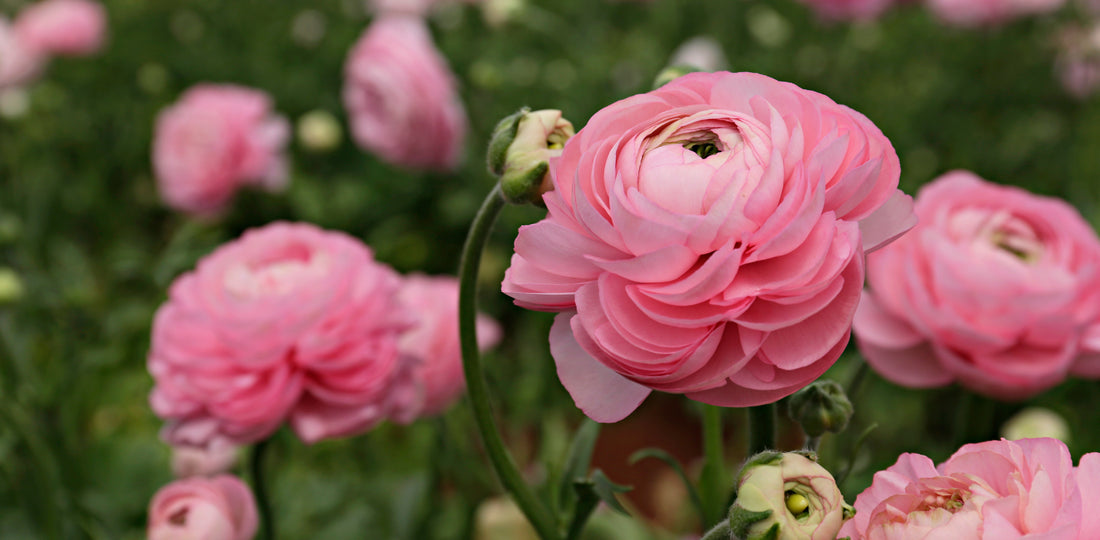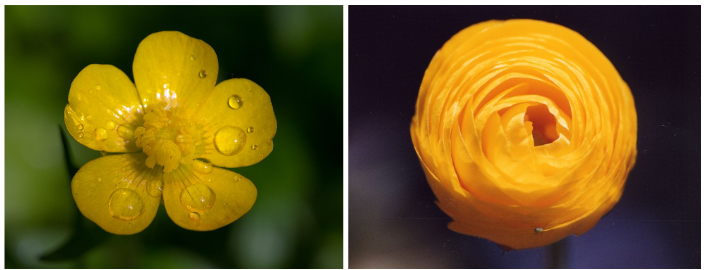
Tissue Culture of Ranunculus

Ranunculus is one of the largest genera of ornamentals with 6000 species. They are mostly perennial, biennial, terrestrial, and aquatic plants. They are commonly known by the name buttercups, water crowfoots, and spearworts.

Introduction
Have you seen in your surrounding a pink, white, or orange color rose-like flowers with multi-layered cup-shaped petals or small beautiful five-petaled yellow flowers? If you’re confused what am I talking about. Look at the picture below!

Figure: An image of creeping buttercup (left-hand side) and Ranunculus asiaticus (right-hand side)
Now you get it. Right!
These are marvelous ravishing plants that pull people’s eyes. And, for their beauty, the ornamental plants are quite popular among the growers, culturists, hobbyists, and plant enthusiasts.
Ranunculus is one of the largest genera of ornamentals with 6000 species. They are mostly perennial, biennial, terrestrial, and aquatic plants. They are commonly known by the name buttercups, water crowfoots, and spearworts.
The plant generally blooms from early spring to summertime, based on the climate. These plants can be grown either by using seeds or tubers. And, while cultivating these plants, the temperature is not below 10° F. That’s it! Then, even with minimal care, these plants can thrive well in the fall in an outdoor environment.
The species Ranunculus asiaticus L. is quite important in the Mediterranean countries, but also in California, Israel, South Africa, and Japan.
Propagation of Ranunculus
Conventionally, Ranunculus is grown from seeds. The rhizomes produced at the end of the year are graded and grown to produce flowers in the second year.
The multiplication of the plant can also be done through tuberous roots. However, it takes a long time as the multiplication rate is slow.
Furthermore, many viral diseases including Tobacco Necrosis Virus (TNV), Cucumber Mosaic Virus (CMV), Tomato Spotted Wilt Virus (TSWV), and Tobacco Rattle Virus (TRV); and some fungi, such as Fusarium tabacinum, Rhizoctonia sp., Pythium sylvaticum, and Fusarium oxysporum f.sp. Ranunculi are major threats to plants cultivated through conventional techniques.
The solution to the proposed challenges is the tissue culture of the plant.
Tissue Culture of Ranunculus
Tissue culture is an effective alternative technique to grow the desired genera of Ranunculus plants. The significant factors affecting the in vitro performance of Ranunculus shoots among others include:
- The water status and availability of nutrients
- The agar brand
- Type of sugar
- Plant density
- Frequency of subculture
- Ventilation of tissue culture vessel
The following tissue culture procedure is represented here from the study of Beruto, M. (2009). In vitro Propagation Through Axillary Shoot Culture of Ranunculus asiaticus L. Methods in Molecular Biology, 29–37. doi:10.1007/978-1-60327-114-1_4.Refer to the complete article: https://pubmed.ncbi.nlm.nih.gov/20099088/
Plant Material
- Collect tuberous roots from the plants.
Media Preparation
Prepare the following media for different tissue culture stages.
| Chemicals | Media recipe for Initiation culture | Media recipe for Shoot Multiplication | Rooting |
| Major elements | Murashige and Skoog | Murashige and Skoog | Murashige and Skoog; half-strength |
| CaCl2 | 2.99 | 2.99 | 1.50 |
| KH2PO4 | 1.25 | 1.25 | 0.63 |
| KNO3 | 18.79 | 18.79 | 9.40 |
| MgSO4 | 1.50 | 1.50 | 0.75 |
| NH4NO3 | 20.61 | 20.61 | 10.30 |
| Iron and minor elements (mM) | Murashige and Skoog | Murashige and Skoog |
Murashige and Skoog;
half-strength |
| CoCl2⋅6H2O | 0.11 | 0.11 | 0.06 |
| CuSO4⋅5H2O | 0.10 | 0.10 | 0.05 |
| FeNaEDTA | 100.0 | 100.0 | 50.0 |
| H3BO3 | 100.27 | 100.27 | 50.14 |
| KI | 5.00 | 5.00 | 2.5 |
| MnSO4⋅H2O | 100.00 | 100.00 | 50.0 |
| Na2MoO4⋅2H2O | 1.03 | 1.03 | 0.52 |
| ZnSO4⋅7H2O |
29.91 |
29.91 | 14.96 |
| Vitamins (mM) | Murashige and Skoog | Murashige and Skoog | |
| Glycine | 26.64 | 26.64 | |
| Myo-Inositol | 554.94 | 554.94 | |
| Nicotinic acid | 4.06 |
4.06 |
|
|
Pyridoxine HCl |
2.43 | 2.43 | |
| Thiamine HCl |
0.30 |
0.30 | |
| Organic addenda | |||
| Sucrose (mM) | 87.64 | 87.64 | 43.82 |
| Fructose (mM) | – | – | 44.40 |
| Citric acid (mM) |
– |
– | 0.39 |
| Ascorbic acid (mM) | – | – | 0.28 |
| Yeast extract (mg/L) | 500 | – | – |
| Peptone (mg/L) | 100 | – | – |
| Growth regulators (mM) | |||
| NAA | 0.11 | ||
| BA | 2.22 | ||
| Kinetin | 9.29 | ||
| IBA | - | 4.92 | - |
- After all the above-mentioned requirements (for each stage of the media) are added in 500 ml distill water, as 8 gram of agar to the media solution and make the volume of the media to 1L or 1000 ml.
- Autoclave the media at 120 C, 101 kPa, for 15 min.
Explant Preparation
- Soak the tuberous roots in water overnight.
- Transfer the roots to a pot containing moist perlite in a way that the upper part stays out.
- Incubate the explants at 10–12 C 8 h light for over about 15–20 days.
- As the culture starts sprouting, prepare the cultures to get started.
Culture Initiation
- Dissect the buds from the tuberous roots.
- Sterilize them by quickly dipping them into 70% (v/v) ethanol followed by a 15 min treatment of NaOCl with 1% available chlorine.
- Rinse the buds three times with sterile water.
- Shake the explants in 50% PPM (v/v) for 10 minutes.
- Transfer the cultures to the media prepared as mentioned in the culture initiation row on the above-given table.
- Incubate the cultures for 16 h, in light/8 h dark, and 50–60mmol/m2/s), at 19±1 C.
Shoot Multiplication
- Prepare multiplication media as given in the table above.
- After 7-8 weeks, transfer the culture to the multiplication medium.
- Keep 10-15 shoots to each culture vessel (containing 100 ml media) and seal with a parafilm or polyethylene film.
- After 2-3 weeks, you will observe a cluster of shoots.
- For subculturing, divide these shoots in aseptic conditions and culture them on a fresh multiplication medium.
Rooting and Acclimatization
- Cut the shoots to 1.5–2.0 cm long and transfer them to the rooting medium.
- After 3-4 weeks you should observe health and well-developed plantlets.
- Transfer the plantlets to the peat-perlite substrate (1:1) under greenhouse
- conditions. Protect the plantlets with a white polypropylene film (17 g/m2) and green shading net (70%) for 2 weeks.
- Remove the polypropylene film gradually. After, the film is completely removed apply a fertilizer with a 0.1% salt concentration in the ratio of 1:0.7:1.1 (N:P: K).
- After a few days, plants will be ready to be transferred to cultivation and production and then can be maintained following natural practices.
How Plant Cell Technology Is Helping Culturists Worldwide In Their Tissue Culture Application?
Plant Cell Technology is helping tissue culturists around the world by providing unique and world-class products and services that smoothen their process. It has MS media, agar, gellan gum, Plant Preservative Mixture (PPM), culture vessels, Biocoupler (TM), and masks in its store to facilitate your processes.
And, that’s not it! Plant Cell Technology also offers consultation services to culturists of all sizes that help to get instant solutions to your tissue culture problems.
So, visit plantcelltechnology.com today and find out more about our product and services and how they help you to excel in your tissue culture processes.
Happy Culturing!!
References
- Beruto, M., & Debergh, P. (2004). Micropropagation of Ranunculus Asiaticus: A Review and Perspectives. Plant Cell, Tissue and Organ Culture, 77(3), 221–230. doi:10.1023/b:ticu.0000018416.38569.7b
- Beruto, M. (2009). In vitro Propagation Through Axillary Shoot Culture of Ranunculus asiaticus L. Methods in Molecular Biology, 29–37. doi:10.1007/978-1-60327-114-1_4
- https://en.wikipedia.org/wiki/Ranunculus
- https://www.gardendesign.com/flowers/ranunculus.ht...
Blog Categories
View by Level
Popular Blogs

6 Plant Tissue Culture Books to Keep Learning
Introduction Most of us are fans of books when it comes to learning a topic in detail and in a...
Read More
New Technical Agar Vs Supreme Agar
Introduction What’s the secret element that supports and holds plants in vitro? Not sure? It’s the solidifying agent. Solidifying agents...
Read MoreSubscribe to Our Newsletter







Join the conversation
Your email address will not be published. Required fields are marked